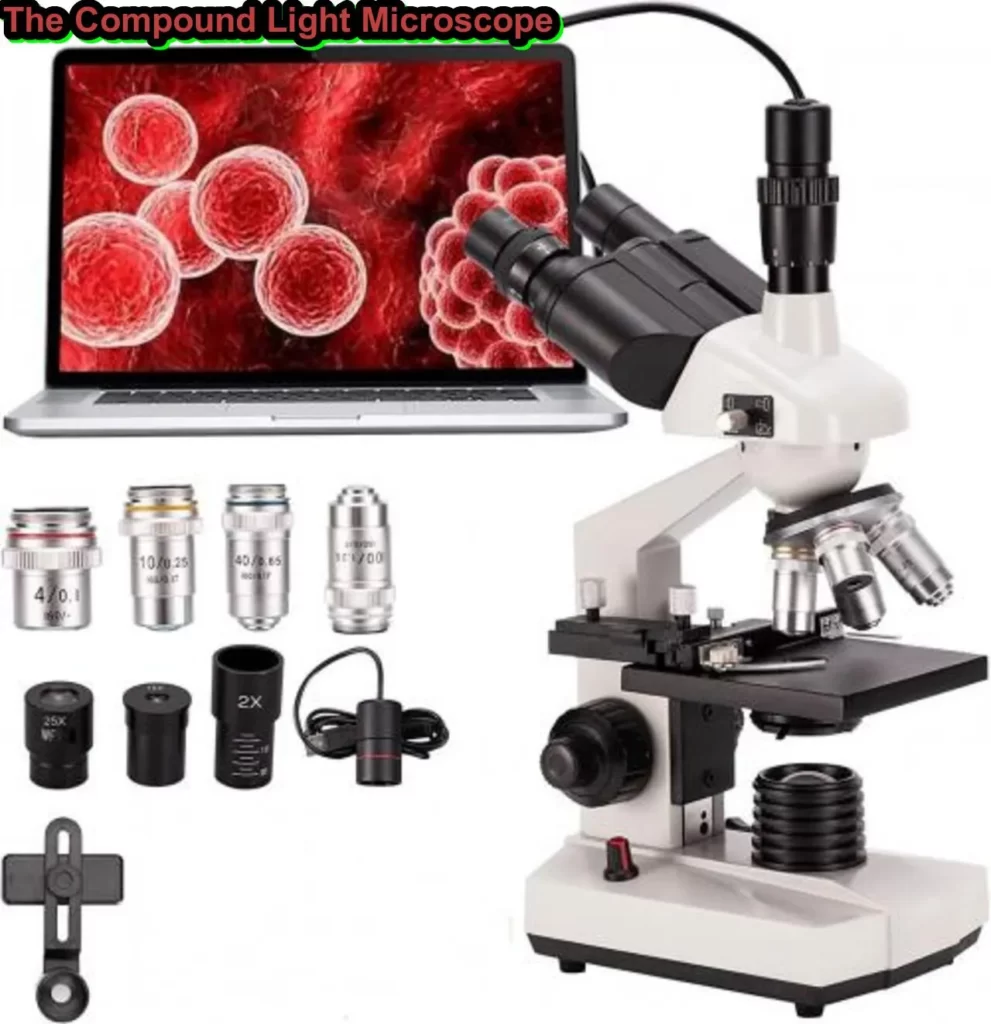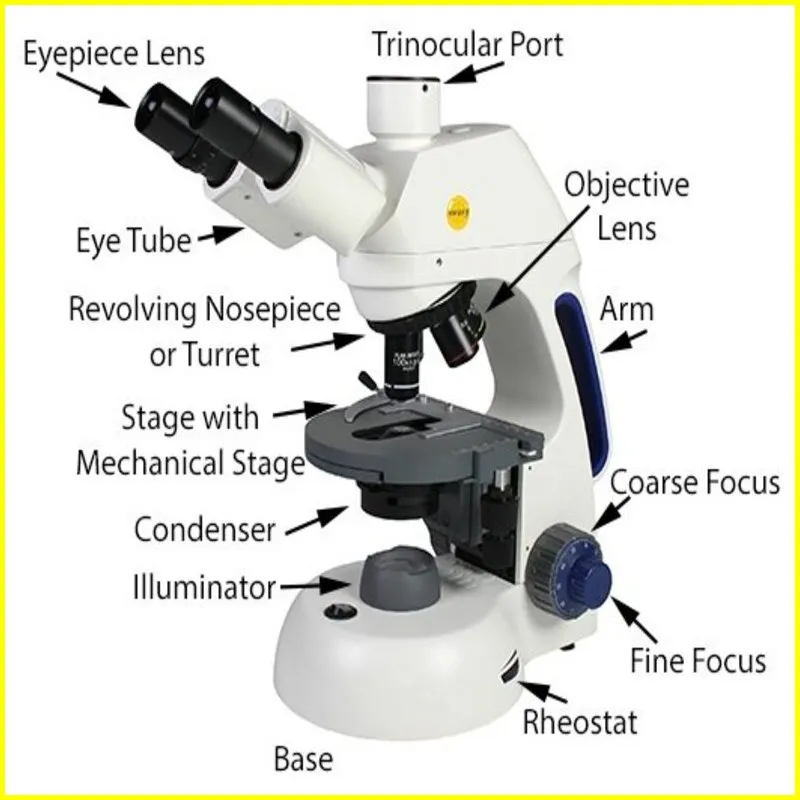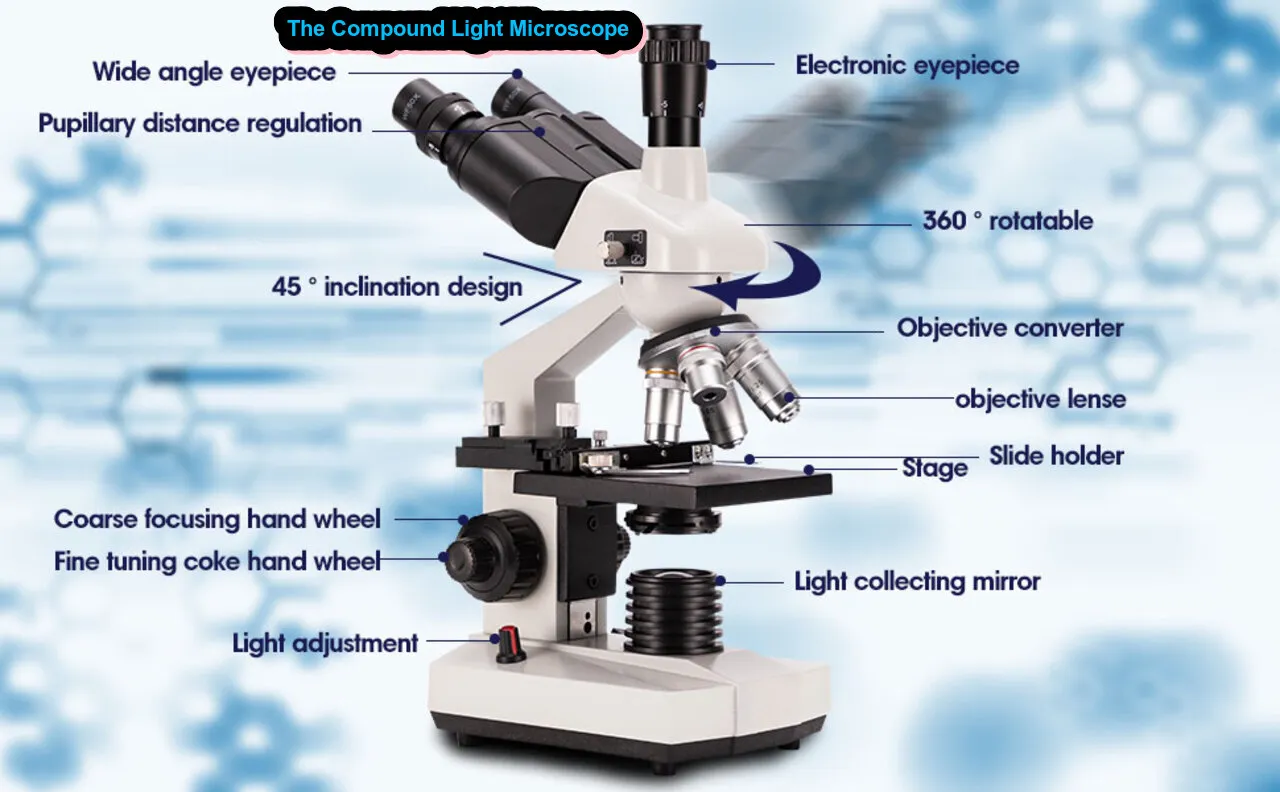The Compound Light Microscope
How are features visible to us that are too tiny for the human eye to see? A compound light microscope is the solution! An overview of this potent instrument, including its optical parts, magnification capabilities, and ideal applications, will be given in this article. Continue reading to discover more about the amazing capabilities of the compound light microscope.
How to Work Compound Light Microscope
There are many procedures involved in using a compound light microscope to guarantee correct functioning and the best possible viewing of specimens. The following is a basic operating manual for a compound light microscope:
1. Turn On the Microscope:
- Ensure that the microscope is placed on a stable surface.
- Check that the power cord is properly connected.
- Turn on the power switch of the microscope.
2. Adjust the Illumination:
- Adjust the light intensity using the brightness control, typically located on the base of the microscope.
- For more advanced microscopes, there may be additional controls for adjusting the light temperature and direction.
3. Choose the Objective Lens:
- Rotate the nosepiece to select the lowest magnification objective lens (usually 4x). The objective lenses are mounted on the nosepiece and can be rotated for different magnifications.
4. Place the Specimen:
- Put the specimen on the stage of the microscope. Use stage clips to secure the specimen in place.
5. Use Coarse Focus:
- While looking through the eyepiece, use the coarse focus adjustment (usually the larger knob on either side of the microscope) to bring the specimen into rough focus.
6. Use Fine Focus:
- Refine the focus using the fine focus adjustment (usually the smaller knob) for sharper details.
7. Adjust the Interpupillary Distance:
- If the microscope has binocular eyepieces, adjust the interpupillary distance (distance between eyepieces) to match the distance between your eyes for comfortable viewing.
8. Adjust the Diopter:
- Some microscopes have a diopter adjustment on one or both eyepieces. Adjust these to ensure the image is in focus for both eyes.
9. Change Objective Lenses:
- To increase magnification, rotate the nosepiece to select a higher magnification objective lens (e.g., 10x, 40x, or 100x). Remember to re-focus using both coarse and fine adjustments.
10. Center the Specimen:
- If the specimen moves out of the field of view when changing objectives, use the stage controls to center it.
11. Use the Mechanical Stage (if available):
- Some microscopes have a mechanical stage with knobs for precise movement of the specimen. Use these controls to navigate the specimen.
12. Turn Off the Microscope:
- When you are finished, turn off the light source and then turn off the microscope.
Tips:
- Always start with the lowest magnification objective to locate and center your specimen.
- Keep the microscope clean, including the lenses and the eyepieces.
- Avoid touching the objective lenses with your fingers; use lens paper to clean them if necessary.
What is the Compound Light Microscope?
An optical microscope that employs light to magnify things is called a compound light microscope. This particular microscope is widely utilized in scientific investigations and has played a significant role in advancing our comprehension of the natural world.
The objective lens and the eyepiece lens make up the compound light microscope’s two lenses. The objective lens forms the picture, which is magnified by the eyepiece lens, which is situated at the top of the microscope. The picture that is magnified by the eyepiece lens is formed by the objective lens, which is positioned underneath it.
You may view a wide range of specimens with the compound light microscope, such as bacteria, cells, and tiny particles. It is frequently used to check tissue samples for imperfections in medical research and to check materials for flaws in industrial settings.

The Optical Components of a Compound Microscope
Compound microscopes enlarge images by using several lenses. Light flows through each lens in turn because they are arranged in a line. The eyepiece, or lens through which you see, is the first lens. The objective lens is the next lens in line. It is attached to a rotating nosepiece that allows you to adjust the magnification by switching between different objective lenses. Most compound microscopes include three or four separate objective lenses that may be used to magnify objects by 4x, 10x, 40x, or 100x. The condenser lens, which focuses light onto the specimen, is the last lens in the optical path.
Most compound microscopes also have an iris diaphragm that controls the amount of light that enters the microscope. By adjusting the iris diaphragm, you can increase or decrease the contrast of the image.
The typical compound microscope has a total magnification of 400x. This means that the image you see through the eyepiece is magnified 400 times compared to what you would see with your naked eye.
Article About:- Health & fitness
Article About:- Medical Technology
Article About:- Sports
Why Use a Compound Microscope?
A compound microscope is a type of optical device that enlarges objects via the use of a lens system. Since its invention in the 17th century, compound microscopes have been applied in many disciplines, such as materials science, biology, and medicine.
Compared to other kinds of microscopes, compound microscopes provide a number of benefits. To start with, compared to other kinds of microscopes, they are more magnified. Secondly, they enable the employment of diverse light sources, such ultraviolet light, which may be employed to scrutinize specimens that prove challenging to see with conventional microscopes. Lastly, compound microscopes don’t require a lot of training to use successfully because they are very simple to use.

Advantages of a Compound Microscope
There are many advantages of a compound microscope over other types of microscopes. The most notable advantage is the higher magnification that can be achieved with a compound microscope. This is due to the use of multiple lenses in the optics system. In addition, the use of light at different wavelengths (colors) can also be used to increase contrast and resolution.
Compound microscopes also have greater control over the direction and intensity of light, which allows for more precise imaging. Additionally, the use of phase contrast or darkfield microscopy can greatly enhance detail in specimens.
Lastly, many modern compound microscopes come equipped with advanced features such as digital cameras and computer-aided software that allow for easy storage, sharing and analysis of images.
Disadvantages of a Compound Microscope
There are several disadvantages to using a compound microscope. First, the image can appear distorted and unclear due to the number of lenses in the system. Second, it can be difficult to keep the specimen in focus due to the need to use multiple lenses. Finally, the light source is typically located below the stage, which can make it difficult to see the specimen.
When Can you Use a Compound Light Microscope?
- An optical microscope that magnifies objects using a set of lenses is called a compound light microscope. Usually, a sequence of two or more lenses is used to organize the lenses.
- The lens that is closest to the thing being observed is the first lens, called the objective lens. The lens next to the observer’s eye is the second lens, sometimes known as the ocular lens.
- The power of the objective lens of a compound light microscope determines its magnification power. The magnification increases with the objective lens’s power.
- The ideal application for a compound light microscope is to observe minute things that need a high magnification, such cells and germs.

FAQ
What is the compound light microscope used for?
Typically in a compound light microscope, a compound microscope is used to view specimens at high magnification (40 – 1000x), achieved by the combined effect of two sets of lenses: the ocular lens (in the eyepiece) and Objective lens (closer to the specimen).
What is compound or light microscope?
This is the definition of a compound microscope. Uses a microscope with a high resolution and two sets of lenses providing a 2-dimensional image of the specimen. The term compound refers to the use of more than one lens in a microscope. At the same time, the compound microscope is one of the important types of optical microscope.
Why is it called compound light microscope?
The compound light microscope is a very advanced instrument consisting of two lenses, which perform magnification, and a variety of knobs are used to move and focus the specimen. Since it uses more than one lens, it is sometimes called a compound microscope in addition to being referred to as a light microscope.
What is the difference between a compound light and electron microscope?
The main difference between these two is compound microscope magnifies the object about 2000 times but electron microscope magnifies the object 200,000 times. Both living and dead cells or specimens can be viewed under a compound microscope. Only dead and dry specimens can be seen in an electron microscope.
What is the Advantages of a Compound Microscope
There are many advantages of a compound microscope over other types of microscopes. The most notable advantage is the higher magnification that can be achieved with a compound microscope. This is due to the use of multiple lenses in the optics system. In addition, the use of light at different wavelengths (colors) can also be used to increase contrast and resolution.
What is the Disadvantages of a Compound Microscope
There are several disadvantages to using a compound microscope. First, the image can appear distorted and unclear due to the number of lenses in the system. Second, it can be difficult to keep the specimen in focus due to the need to use multiple lenses.
100X-2000X Microscopes for Kids Students Adults, with Microscope Slides Set, Phone Adapter, Powerful Biological Microscopes for School Laboratory Home Education.
- High Magnification
- Coarse and Fine Focus
- Dual Illumination System
- Complete Accessories
- Practical Educational Tool





